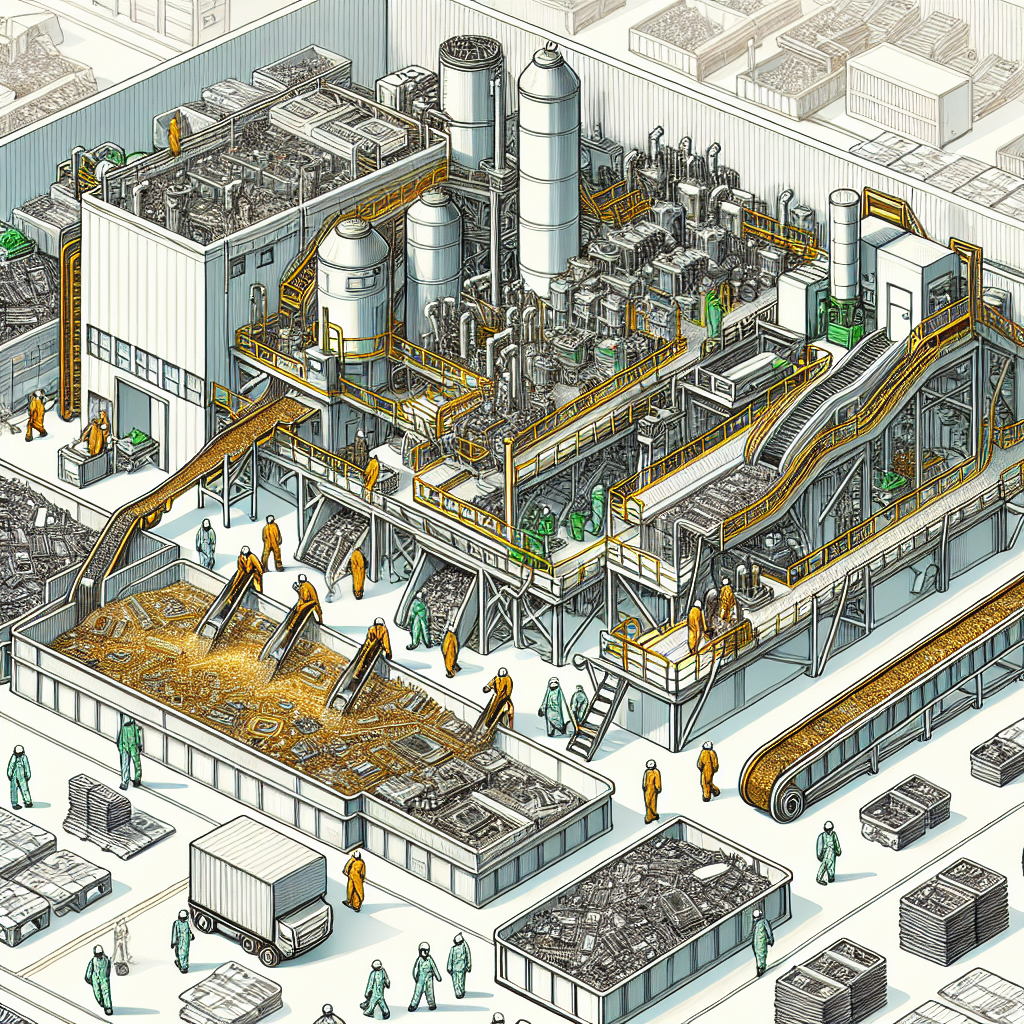Scientists at the University of Toulouse in France have made a cool discovery. They’ve created an enzyme called LCCICCG that can break down plastic waste. This enzyme is really good at breaking down a type of plastic called PET, which is used in things like plastic packaging and polyester clothing. It can break down the PET plastic into smaller pieces, which can then be used to make new plastic. The scientists have built a plant in France where they plan to recycle 50,000 tonnes of PET waste each year by 2025.
The company behind the enzyme is called Carbios. They don’t want to do the recycling themselves, but they want to let other companies use their process. They’ve teamed up with big brands like Nestle, L’Oréal, and PepsiCo. The enzyme they made is a bit more expensive than the chemicals used in regular plastic, but the CEO of Carbios thinks that as they get more materials, the cost will go down.
There are other scientists working on recycling plastic too, but Carbios is the first to scale up their process. Professor Andy Pickford from the University of Portsmouth thinks it’s a good idea and hopes more people will support it. He also thinks we should try to use less plastic in the first place. Right now, less than 10% of plastic is recycled, and most of it ends up in landfills. Carbios wants to keep working on their enzyme and find ways to break down other types of plastic too, like nylon. They hope their work can help solve the plastic waste problem and make the world a better place.
Original news source: The T-shirt chewing enzyme ready to tackle plastic waste (BBC)
Listen
Slow
Normal
Fast
Group or Classroom Activities
Warm-up Activities:
– News Summary
Instructions:
1. Divide the class into pairs or small groups.
2. Give each group a copy of the article.
3. Ask the groups to read the article and summarize it in a paragraph or two.
4. Have each group share their summary with the rest of the class.
– Opinion Poll
Instructions:
1. Divide the class into pairs.
2. Ask each pair to discuss their opinions on the topic of plastic waste and recycling.
3. After the discussion, have each pair create a short opinion poll with 5-10 questions related to plastic waste and recycling.
4. Have the pairs exchange their polls and answer each other’s questions.
5. Discuss the results as a class and compare opinions.
– Sketch It
Instructions:
1. Divide the class into pairs.
2. Give each pair a different sentence or phrase from the article related to plastic waste and recycling.
3. Ask the pairs to create a quick sketch or drawing to represent their sentence or phrase.
4. Have each pair share their sketch with the rest of the class and explain its connection to the article.
– Vocabulary Pictionary
Instructions:
1. Divide the class into two teams.
2. Write down 10-15 vocabulary words from the article related to plastic waste and recycling on small pieces of paper.
3. One member from each team takes turns choosing a word and drawing it on the board without using any letters or numbers.
4. The team members must guess the word based on the drawing within a time limit.
5. The team that guesses the most words correctly wins.
– Pros and Cons
Instructions:
1. Divide the class into small groups.
2. Assign each group a different aspect of the article related to plastic waste and recycling (e.g. the discovery of the enzyme, the collaboration with big brands, the cost of the enzyme, etc.).
3. Ask each group to discuss the pros and cons of their assigned aspect and write them down.
4. Have each group present their pros and cons to the rest of the class.
5. Encourage class discussion and debate on the different aspects of the article.
Comprehension Questions:
1. What have scientists at the University of Toulouse discovered?
2. What is the name of the enzyme that can break down plastic waste?
3. What type of plastic is the enzyme good at breaking down?
4. What can the PET plastic be used for after it is broken down?
5. What is the name of the company behind the enzyme?
6. Which big brands have teamed up with Carbios?
7. Why is the enzyme more expensive than regular plastic chemicals?
8. What does Professor Andy Pickford hope will happen with Carbios’ process?
Go to answers ⇩
Listen and Fill in the Gaps:
Scientists at the University of Toulouse in France have made a cool (1)______. They’ve (2)______ an enzyme (3)______ LCCICCG that can break down plastic (4)______. This enzyme is really good at breaking down a type of plastic called PET, which is used in things like plastic packaging and polyester clothing. It can break down the PET plastic into smaller pieces, which can then be used to make new plastic. The scientists have (5)______ a (6)______ in France where they plan to recycle 50,000 tonnes of PET waste each year by 2025.
The (7)______ behind the enzyme is called Carbios. They don’t want to do the recycling themselves, but they want to let other (8)______ use their process. They’ve teamed up with big brands like Nestle, L’Oréal, and PepsiCo. The enzyme they made is a bit more expensive than the chemicals used in regular (9)______, but the CEO of Carbios thinks that as they get more materials, the cost will go down.
There are other scientists (10)______ on recycling plastic too, but Carbios is the first to scale up their process. Professor Andy Pickford from the University of Portsmouth thinks it’s a good idea and (11)______ more (12)______ will support it. He also (13)______ we should try to use less plastic in the (14)______ place. Right now, less than 10% of plastic is recycled, and most of it ends up in (15)______. Carbios wants to keep working on their enzyme and find ways to (16)______ down other types of plastic too, like nylon. They hope their work can help solve the plastic waste problem and make the world a better place.
Go to answers ⇩
Discussion Questions:
Students can ask a partner these questions, or discuss them as a group.
1. What is plastic waste and why is it a problem?
2. How do you feel about the discovery of the enzyme that can break down plastic waste?
3. Do you think it’s important for companies to recycle plastic? Why or why not?
4. Have you ever thought about the impact of plastic waste on the environment?
5. How would you feel if more companies started using the enzyme to recycle plastic?
6. Do you think it’s a good idea for companies to team up and work together to solve the plastic waste problem? Why or why not?
7. What are some ways you can personally reduce your use of plastic?
8. How do you think the world would be different if more plastic was recycled?
9. What are some other types of plastic that you think should be recycled?
10. How do you think the discovery of the enzyme will affect the cost of plastic?
11. What do you think are the biggest challenges in recycling plastic?
12. Do you think the government should implement stricter regulations on plastic waste? Why or why not?
13. Have you ever seen plastic waste in your community? How does it make you feel?
14. What steps do you think individuals can take to encourage more recycling of plastic?
15. How do you think the world would be different if there was no plastic waste?
Individual Activities
Vocabulary Meanings:
Match each word to its meaning.
Words:
1. enzyme
2. plastic
3. waste
4. recycle
5. process
6. scale up
7. landfills
8. nylon
Meanings:
(a) Sites where waste is buried underground
(b) To increase the size or scope of something
(c) A substance that can break down materials
(d) A type of synthetic material used in clothing
(e) A series of actions or steps to achieve a particular result
(f) To convert waste materials into new products
(g) A material that is made from chemicals and is not biodegradable
(h) Unwanted or unused materials that are thrown away
Go to answers ⇩
Multiple Choice Questions:
1. What have scientists at the University of Toulouse created?
(a) A new type of plastic packaging
(b) An enzyme called LCCICCG
(c) A plant for recycling plastic waste
(d) Polyester clothing
2. What type of plastic is the enzyme good at breaking down?
(a) Nylon
(b) Polyester
(c) PET
(d) Regular plastic
3. What can the smaller pieces of plastic be used for?
(a) Building a plant
(b) Making new plastic
(c) Recycling other materials
(d) Creating polyester clothing
4. Which company is behind the enzyme?
(a) Nestle
(b) L’Oréal
(c) PepsiCo
(d) Carbios
5. What is the CEO of Carbios’ opinion about the cost of the enzyme?
(a) The cost will go down as they get more materials
(b) The cost will stay the same
(c) The cost will increase over time
(d) The cost will depend on the type of plastic
6. Who has Carbios teamed up with?
(a) The University of Toulouse
(b) Professor Andy Pickford
(c) Other recycling companies
(d) Nestle, L’Oréal, and PepsiCo
7. What does Professor Andy Pickford hope for?
(a) More support for Carbios’ process
(b) More plastic waste in landfills
(c) Less plastic being used
(d) More companies working on recycling plastic
8. What is Carbios’ goal for their enzyme?
(a) To create more plastic packaging
(b) To build more recycling plants
(c) To break down other types of plastic
(d) To solve the plastic waste problem
Go to answers ⇩
True or False Questions:
1. Carbios is not the first company to scale up their plastic recycling process, while other scientists are also not working on similar projects.
2. The enzyme is currently not more expensive than the chemicals used in regular plastic, and the cost is not expected to decrease as more materials become available.
3. Carbios hopes to continue developing their enzyme to break down other types of plastic, such as nylon, in order to address the plastic waste problem.
4. Carbios, the company behind the enzyme, plans to recycle 50,000 tonnes of PET waste each year by 2025.
5. Scientists at the University of Toulouse in France have not created an enzyme called LCCICCG that can break down plastic waste.
6. Carbios wants other companies to use their recycling process and has partnered with big brands like Nestle, L’Oréal, and PepsiCo.
7. The enzyme is especially good at breaking down PET plastic, which is commonly used in plastic packaging and polyester clothing.
8. The enzyme does not break down the PET plastic into smaller pieces that can be used to make new plastic.
Go to answers ⇩
Write a Summary:
Write a summary of this news article in two sentences.
Check your writing now with the best free AI for English writing!
Writing Questions:
Answer the following questions. Write as much as you can for each answer.
Check your answers with our free English writing assistant!
1. What have scientists at the University of Toulouse discovered?
2. What type of plastic can the enzyme break down?
3. What can the smaller pieces of plastic be used for?
4. Who is the company behind the enzyme and what do they want to do with it?
5. Why does Professor Andy Pickford think it’s important to use less plastic?
Answers
Comprehension Question Answers:
1. What have scientists at the University of Toulouse discovered?
Scientists at the University of Toulouse have discovered an enzyme that can break down plastic waste.
2. What is the name of the enzyme that can break down plastic waste?
The enzyme that can break down plastic waste is called LCCICCG.
3. What type of plastic is the enzyme good at breaking down?
The enzyme is good at breaking down a type of plastic called PET.
4. What can the PET plastic be used for after it is broken down?
After PET plastic is broken down, it can be used to make new plastic.
5. What is the name of the company behind the enzyme?
The company behind the enzyme is called Carbios.
6. Which big brands have teamed up with Carbios?
Carbios has teamed up with big brands like Nestle, L’Oréal, and PepsiCo.
7. Why is the enzyme more expensive than regular plastic chemicals?
The enzyme is more expensive than regular plastic chemicals because it is a new technology and the production process is not yet fully optimized.
8. What does Professor Andy Pickford hope will happen with Carbios’ process?
Professor Andy Pickford hopes that more people will support Carbios’ process and that it will help solve the plastic waste problem. He also hopes that people will try to use less plastic in the first place.
Go back to questions ⇧
Listen and Fill in the Gaps Answers:
(1) discovery
(2) created
(3) called
(4) waste
(5) built
(6) plant
(7) company
(8) companies
(9) plastic
(10) working
(11) hopes
(12) people
(13) thinks
(14) first
(15) landfills
(16) break
Go back to questions ⇧
Vocabulary Meanings Answers:
1. enzyme
Answer: (c) A substance that can break down materials
2. plastic
Answer: (g) A material that is made from chemicals and is not biodegradable
3. waste
Answer: (h) Unwanted or unused materials that are thrown away
4. recycle
Answer: (f) To convert waste materials into new products
5. process
Answer: (e) A series of actions or steps to achieve a particular result
6. scale up
Answer: (b) To increase the size or scope of something
7. landfills
Answer: (a) Sites where waste is buried underground
8. nylon
Answer: (d) A type of synthetic material used in clothing
Go back to questions ⇧
Multiple Choice Answers:
1. What have scientists at the University of Toulouse created?
Answer: (b) An enzyme called LCCICCG
2. What type of plastic is the enzyme good at breaking down?
Answer: (c) PET
3. What can the smaller pieces of plastic be used for?
Answer: (b) Making new plastic
4. Which company is behind the enzyme?
Answer: (d) Carbios
5. What is the CEO of Carbios’ opinion about the cost of the enzyme?
Answer: (a) The cost will go down as they get more materials
6. Who has Carbios teamed up with?
Answer: (d) Nestle, L’Oréal, and PepsiCo
7. What does Professor Andy Pickford hope for?
Answer: (a) More support for Carbios’ process
8. What is Carbios’ goal for their enzyme?
Answer: (c) To break down other types of plastic
Go back to questions ⇧
True or False Answers:
1. Carbios is not the first company to scale up their plastic recycling process, while other scientists are also not working on similar projects. (Answer: False)
2. The enzyme is currently not more expensive than the chemicals used in regular plastic, and the cost is not expected to decrease as more materials become available. (Answer: False)
3. Carbios hopes to continue developing their enzyme to break down other types of plastic, such as nylon, in order to address the plastic waste problem. (Answer: True)
4. Carbios, the company behind the enzyme, plans to recycle 50,000 tonnes of PET waste each year by 2025. (Answer: True)
5. Scientists at the University of Toulouse in France have not created an enzyme called LCCICCG that can break down plastic waste. (Answer: False)
6. Carbios wants other companies to use their recycling process and has partnered with big brands like Nestle, L’Oréal, and PepsiCo. (Answer: True)
7. The enzyme is especially good at breaking down PET plastic, which is commonly used in plastic packaging and polyester clothing. (Answer: True)
8. The enzyme does not break down the PET plastic into smaller pieces that can be used to make new plastic. (Answer: False)
Go back to questions ⇧













